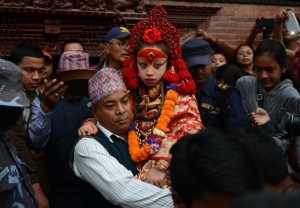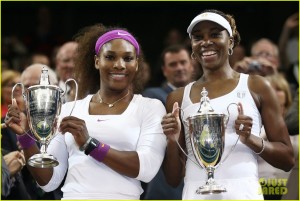In the US – and probably elsewhere where the movie Frozen has been popular – little girls are dressing up as princesses (and buying lots of princess-related merchandise). There was a reminder this week that there are in fact parts of the world where young girls get the royal treatment, namely through a story on NPR about one of Nepal’s “Living Goddesses”, the Kumari Devi, age 9. The story of her experience during the recent earthquake offers a mirror on Nepalese culture as well as insight into how the natural environment is seen in that country. The goddess is worshipped by both Hindus and Buddhists, considered the incarnation of the Hindu goddess Durga. She’s selected as a young child and lives an isolated and secretive existence and is rarely seen in public. According to the story, “Last month’s earthquake brought much of Kathmandu’s historic Durbar Square, a World Heritage Site, tumbling to the ground. Nepal’s showcase temples and palaces were reduced to ruins. But save for a few cracks, the home of the city’s Living Goddess remained intact.” According to the goddess’s caretaker Gautam Shakya, the building’s square shape stabilized it, but a priest cited in the story claims it was nothing so mundane: “It’s the power of the goddess; it’s about faith…It’s been the home of Kumaris for ages and we believe the force of that goddess made the house safe.” This is in keeping with an attitude towards the natural environment at odds with mainstream Western views, which maintain a secular perspective informed by modern environmental science. Whether the Nepalese view makes it any easier to deal with the devastation and loss of life caused by the earthquake is yet to be seen.
Nepal is majority Hindu country, with about 80% of the population, and around 10% Buddhist. But the Kumari Devi transcends and integrates the two religions:
Kumaris are drawn from the Newar community, the original inhabitants of the Kathmandu Valley for whom planets, karma and an array of gods play a vital role in day-to-day life. Gautam Shakya, in the eleventh generation of Kumari caretakers, says they are Buddhists who adopted the Hindu caste system and embody harmony. “One doesn’t discriminate against the other. We Newars are Buddhist. The Kumari is from a Buddhist family — but she is a Hindu goddess,” he says.
That makes the Kumari Devi not only a divine being, but a symbol of religions coming together, something the world could use more of these days. The life of the Kumari is led mostly in private, with most of her time spent with priests, with only rare public appearances. People strive to see her, as that is considered to bring good luck. When she does appear in public, her feet never touch the ground, being carried in a golden palanquin. She always wears red and has a “third eye” painted on her forehead. But the princess life does not last. The Kumar devi keeps her divine position only till puberty, at which time another young girl is selected through an elaborate and mostly secretive process.
A documentary in 2007 chronicled the life of Kumaris in Nepal:

